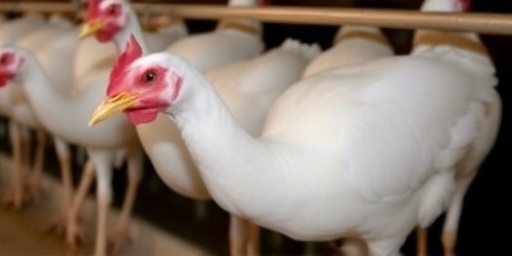In a escalating public health concern, two dairy farm workers in California’s Central Valley have tested positive for the highly pathogenic H5N1 Bird flu virus, marking the first human cases in the state. The Centers for Disease Control and Prevention (CDC) has issued a formal CDC alert urging heightened vigilance among dairy workers nationwide, while emphasizing that the risk to the general public remains low.
The infections, confirmed through PCR testing on Friday, involve workers at separate dairy operations in Fresno and Tulare counties, both hotspots for recent outbreaks in cattle herds. Symptoms reported include mild conjunctivitis and respiratory issues, consistent with prior U.S. human cases linked to Bird flu exposure. Health officials acted swiftly, administering antiviral treatments like oseltamivir (Tamiflu) to the affected individuals, who are now recovering at home in isolation.
This development comes amid a nationwide surge in H5N1 detections in dairy cows, with over 150 herds affected across 13 states since March 2024. California’s dairy industry, the nation’s largest producer of milk and cheese, has reported more than 40 infected herds, prompting emergency pasteurization protocols and raw milk recalls.
California Dairy Farms Ground Zero for H5N1 Spread
The epicenter of this outbreak lies in California’s sprawling dairy operations, where high-density cow housing facilitates rapid virus transmission. State veterinarians first detected H5N1 in cattle in Tulare County in early April, leading to quarantines and depopulation of infected animals. “These dairy workers likely contracted the virus through direct contact with infected cows or contaminated milk during milking,” explained Dr. Karen Fong, California’s State Veterinarian, in a press briefing.
One worker, a 32-year-old milker from a 5,000-cow herd in Fresno, reported eye redness and fatigue after handling a symptomatic cow. The second case, a 45-year-old supervisor in Tulare, experienced cough and fever following exposure to unpasteurized milk splashes. Both tested negative for seasonal flu but positive for H5N1 clade 2.3.4.4b, the same strain circulating in U.S. livestock.
California’s Department of Food and Agriculture (CDFA) has ramped up testing, screening over 1,200 cows weekly. Genetic sequencing revealed no mutations indicating enhanced human-to-human transmissibility, a critical finding echoed in the CDC alert. However, the state has distributed 10,000 doses of antivirals to farms and launched contact tracing for over 50 exposed workers.
Industry leaders are feeling the strain. The California Milk Advisory Board reported a 5% dip in raw milk supply last month, with processors like Land O’Lakes implementing enhanced biosecurity measures such as personal protective equipment (PPE) mandates and ventilation upgrades.
CDC Alert Sparks Nationwide Dairy Worker Monitoring
The CDC alert, released Saturday, directs state health departments to prioritize surveillance among dairy workers, veterinarians, and slaughterhouse employees. “While human infections remain rare and mild, we must act decisively to protect our agricultural workforce,” stated CDC Director Dr. Mandy Cohen in an official statement.
Key recommendations include immediate medical evaluation for symptoms like conjunctivitis, fever, or cough in at-risk groups; provision of N95 respirators and eye protection; and voluntary reporting of ill animals. The CDC has shipped 100,000 antiviral courses to affected states and activated its Health Alert Network for real-time updates.
Since the U.S. Bird flu outbreak began in dairy cows, 13 human cases have been confirmed nationwide—nine in Michigan, two in Texas, one in Colorado, and now two in California. All involved direct animal exposure, with no evidence of community spread. Globally, H5N1 has caused 889 human cases and 463 deaths since 2003, per WHO data, primarily from poultry but increasingly from mammals.
- Human Case Statistics: U.S. total: 13 (mild symptoms, no hospitalizations)
- Dairy Herds Affected: 150+ across 13 states
- Antiviral Stockpile: 1 million+ doses ready for deployment
Federal funding of $1 billion for livestock health, announced last week, includes grants for farm upgrades and rapid testing kits.
Tracing H5N1 Transmission Paths in Dairy Operations
H5N1 bird flu jumped from wild birds to U.S. cattle via contaminated feed or water, experts believe. In dairy settings, the virus sheds in high concentrations in milk—up to 10^9 viral particles per milliliter in infected udders—posing risks during hand-milking or machine cleaning.
A study published in Emerging Infectious Diseases last month analyzed milk samples from Colorado cases, finding viable virus persisting post-pasteurization if improperly heated. The FDA assures pasteurized products are safe, with no human illnesses linked to commercial milk. Raw milk sales, however, face bans in several states amid bird flu fears.
“Workers splash milk in their faces or inhale aerosols; that’s the pathway,” noted Dr. Angela Rasmussen, a virologist at the University of Washington. She advocates for robotic milking systems to minimize contact. Biosecurity lapses, like shared equipment without disinfection, exacerbate spread.
In California, farms now require twice-daily cow health checks and isolate lactating animals. The USDA’s Animal and Plant Health Inspection Service (APHIS) reports a 20% drop in new herd infections since May, crediting these interventions.
Public Health Experts Assess Broader H5N1 Risks
Despite the CDC alert, officials stress low public risk. “Person-to-person transmission hasn’t occurred in the U.S., and cooking destroys the virus,” affirmed Dr. Tom Frieden, former CDC director, in an NPR interview. Vulnerable groups include the immunocompromised and young children, though no pediatric cases exist.
Economically, the dairy sector faces $1.2 billion in losses from culling and reduced yields, per USDA estimates. Milk production fell 2% nationally in Q2 2024. Consumer prices have risen 4%, hitting families amid inflation.
Internationally, Europe reports similar cattle outbreaks, with the EU culling 1,000+ animals. Vaccine trials for cattle show 80% efficacy in early data, potentially available by 2025.
Quotes from the frontlines underscore urgency. “We’ve lost 200 cows; workers are scared,” said a Michigan farm owner. A Texas dairy worker recovered from conjunctivitis added, “PPE saved me—wear it.”
Future Surveillance and Dairy Industry Safeguards Ahead
Looking ahead, the CDC plans genomic surveillance dashboards tracking H5N1 mutations, partnering with Seqirus for human vaccines if needed (94% effective against current strains). States like California are piloting wastewater monitoring for early detection.
The dairy industry commits to “One Health” approaches, integrating animal, human, and environmental monitoring. Federal incentives offer $500 million for biosecure barns and training programs reaching 50,000 dairy workers.
As summer milking peaks, experts warn of intensified spread risks from heat-stressed herds. “Proactive measures now prevent pandemics later,” urges WHO’s Dr. Maria Van Kerkhove. With robust response systems, the U.S. aims to contain bird flu before it evolves further, safeguarding food security and public health.
Stay informed via CDC updates, and report symptoms if in high-risk occupations. This outbreak tests America’s preparedness, but coordinated action offers hope for containment.









